Filter by

The Elderly in the Emergency Department
The evaluation, treatment, and prognosis of the elderly hospitalized in an emergency service are different from the adult patient, and it is necessary to know their particularities to provide optimal care.
- Edition
- -
- ISBN/ISSN
- 9781789232523
- Collation
- -
- Series Title
- -
- Call Number
- -
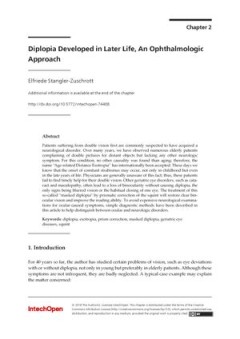
Diplopia Developed in Later Life, An Ophthalmologic Approach
Patients suffering from double vision first are commonly suspected to have acquired a neurological disorder. Over many years, we have observed numerous elderly patients complaining of double pictures for distant objects but lacking any other neurologic symptom. For this condition, no other causality was found than aging; therefore, the name “Age-related Distance Esotropia” has international…
- Edition
- -
- ISBN/ISSN
- 9781789237603
- Collation
- -
- Series Title
- -
- Call Number
- -
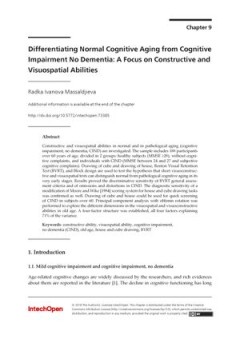
Differentiating Normal Cognitive Aging From Cognitive Impairment No Dementia …
Constructive and visuospatial abilities in normal and in pathological aging (cognitive impairment, no dementia, CIND) are investigated. The sample includes 188 participants over 60 years of age, divided in 2 groups: healthy subjects (MMSE ≥28), without cognitive complaints, and individuals with CIND (MMSE between 24 and 27 and subjective cognitive complains). Drawing of cube and drawing of ho…
- Edition
- -
- ISBN/ISSN
- 9781789232523
- Collation
- -
- Series Title
- -
- Call Number
- -
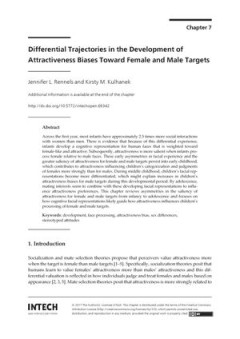
Differential Trajectories in the Development of Attractiveness Biases Toward …
Across the first year, most infants have approximately 2.5 times more social interactions with women than men. There is evidence that because of this differential experience, infants develop a cognitive representation for human faces that is weighted toward female-like and attractive. Subsequently, attractiveness is more salient when infants process female relative to male faces. These early as…
- Edition
- -
- ISBN/ISSN
- 9789535135814
- Collation
- -
- Series Title
- -
- Call Number
- -
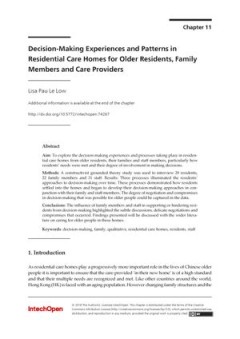
Decision-Making Experiences and Patterns in Residential Care Homes for Older …
Aim: To explore the decision-making experiences and processes taking place in residential care homes from older residents, their families and staff members, particularly how residents’ needs were met and their degree of involvement in making decisions.
- Edition
- -
- ISBN/ISSN
- 9781789232523
- Collation
- -
- Series Title
- -
- Call Number
- -
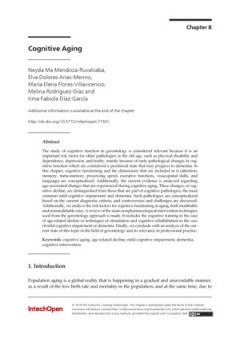
Cognitive Aging
The study of cognitive function in gerontology is considered relevant because it is an important risk factor for other pathologies in the old age, such as physical disability and dependence, depression, and frailty, mainly because of early pathological changes in cognitive function which are considered a preclinical state that may progress to dementia. In this chapter, cognitive functioning and…
- Edition
- -
- ISBN/ISSN
- 9781789232523
- Collation
- -
- Series Title
- -
- Call Number
- -
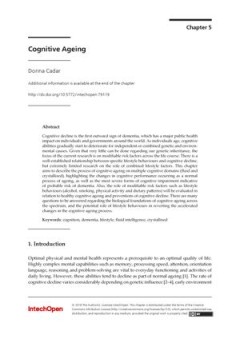
Cognitive Ageing
Cognitive decline is the first outward sign of dementia, which has a major public health impact on individuals and governments around the world. As individuals age, cognitive abilities gradually start to deteriorate for independent or combined genetic and environmental causes. Given that very little can be done regarding our genetic inheritance, the focus of the current research is on modifiabl…
- Edition
- -
- ISBN/ISSN
- 9781789237603
- Collation
- -
- Series Title
- -
- Call Number
- -

Characteristics of Hearing in Elderly People
The authors define the term presbycusis and discuss the prevalence of hearing loss in elderly people, its etiology, and methods of diagnostics (anamnesis, evaluation of the peripheral and central parts of the hearing system). The authors emphasize that central auditory processing disorder (CAPD) significantly impairs speech perception in elderly people and makes difficult the rehabilitation of …
- Edition
- -
- ISBN/ISSN
- 9781789232523
- Collation
- -
- Series Title
- -
- Call Number
- -
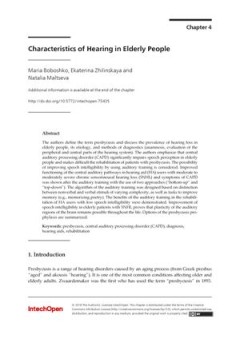
Characteristics of Hearing in Elderly People
The authors define the term presbycusis and discuss the prevalence of hearing loss in elderly people, its etiology, and methods of diagnostics (anamnesis, evaluation of the peripheral and central parts of the hearing system). The authors emphasize that central auditory processing disorder (CAPD) significantly impairs speech perception in elderly people and makes difficult the rehabilitation of …
- Edition
- -
- ISBN/ISSN
- 9781789232523
- Collation
- -
- Series Title
- -
- Call Number
- -
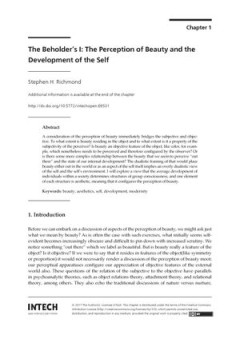
The Beholder’S I The Perception of Beauty and The Development of The Self
A consideration of the perception of beauty immediately bridges the subjective and objective. To what extent is beauty residing in the object and to what extent is it a property of the subjectivity of the perceiver? Is beauty an objective feature of the object, like color, for example, which nonetheless needs to be perceived and therefore configured by the observer? Or is there some more comple…
- Edition
- -
- ISBN/ISSN
- 9789535135814
- Collation
- -
- Series Title
- -
- Call Number
- -
 Computer Science, Information & General Works
Computer Science, Information & General Works  Philosophy & Psychology
Philosophy & Psychology  Religion
Religion  Social Sciences
Social Sciences  Language
Language  Pure Science
Pure Science  Applied Sciences
Applied Sciences  Art & Recreation
Art & Recreation  Literature
Literature  History & Geography
History & Geography